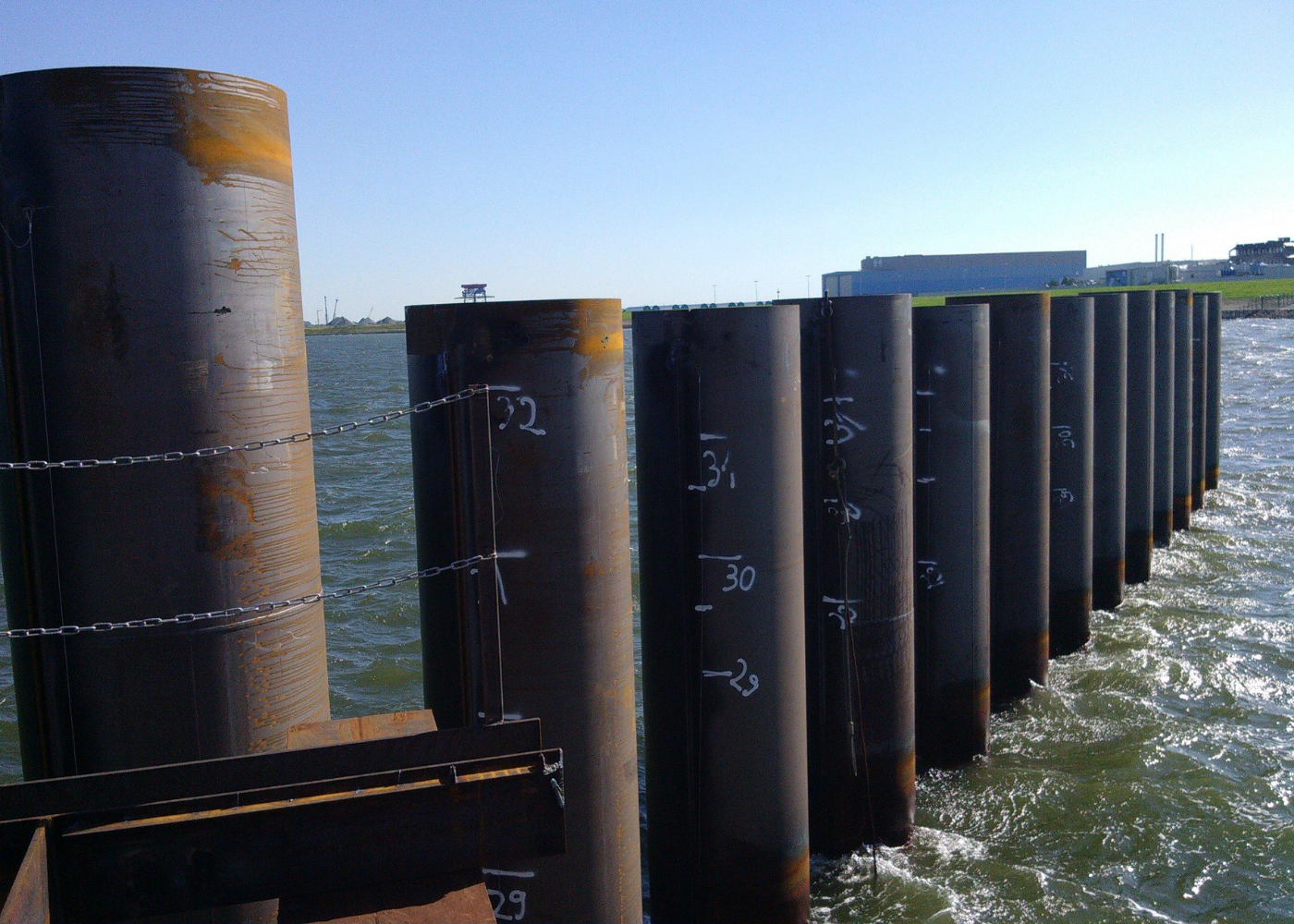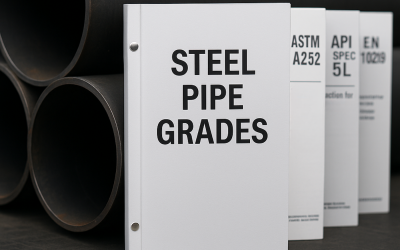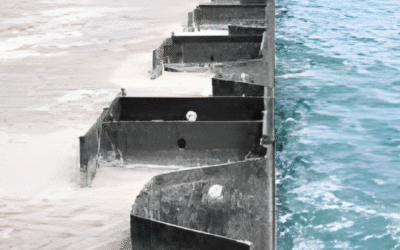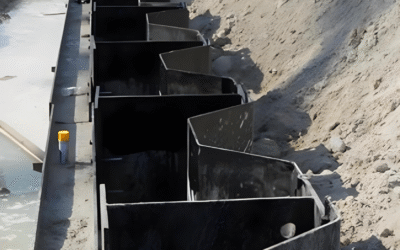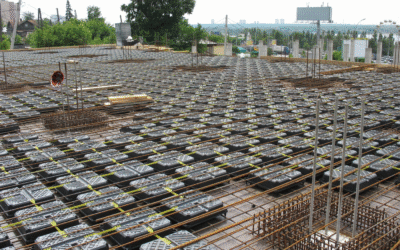Introduction: What Are King Piles?
In large-scale marine and civil engineering projects, sheet piles alone often lack the structural stiffness required to withstand heavy lateral loads, deep excavations, or long retaining walls. To address this, king piles are used as the primary load-bearing elements in combi wall systems.
A king pile is a vertical structural element—often an H pile, pipe pile, or box pile—that serves as the primary supporting member of a retaining wall. Between these king piles, lighter sheet piles are installed, creating a system that balances strength, efficiency, and cost. King piles are typically spaced at ~2.0–3.5 m centres (project-dependent), with tie rods and walings transferring loads to an anchor line or relieving platform.
From quay walls in busy ports to foundations for offshore wind structures, king piles are vital in providing the backbone for walls exposed to water pressure, soil loads, and dynamic forces in the construction industry.

Key Characteristics of King Piles
- Primary Load-Bearing Capacity: Carry the majority of vertical and lateral loads; infill sheets primarily retain soil/water.
- Structural Stiffness: Designed to resist bending moments where sheet piles alone would fail.
- Versatility in Form: Can be fabricated as H beams, tubular pipes, or welded box piles, depending on project requirements.
- Integration with Sheet Piles: Feature locks (interlocking points) or welded connectors to integrate with infill sheet piles.
- Adaptability: Manufactured in a wide size range, high steel grades (S355–S460), and with coatings suitable for marine conditions.
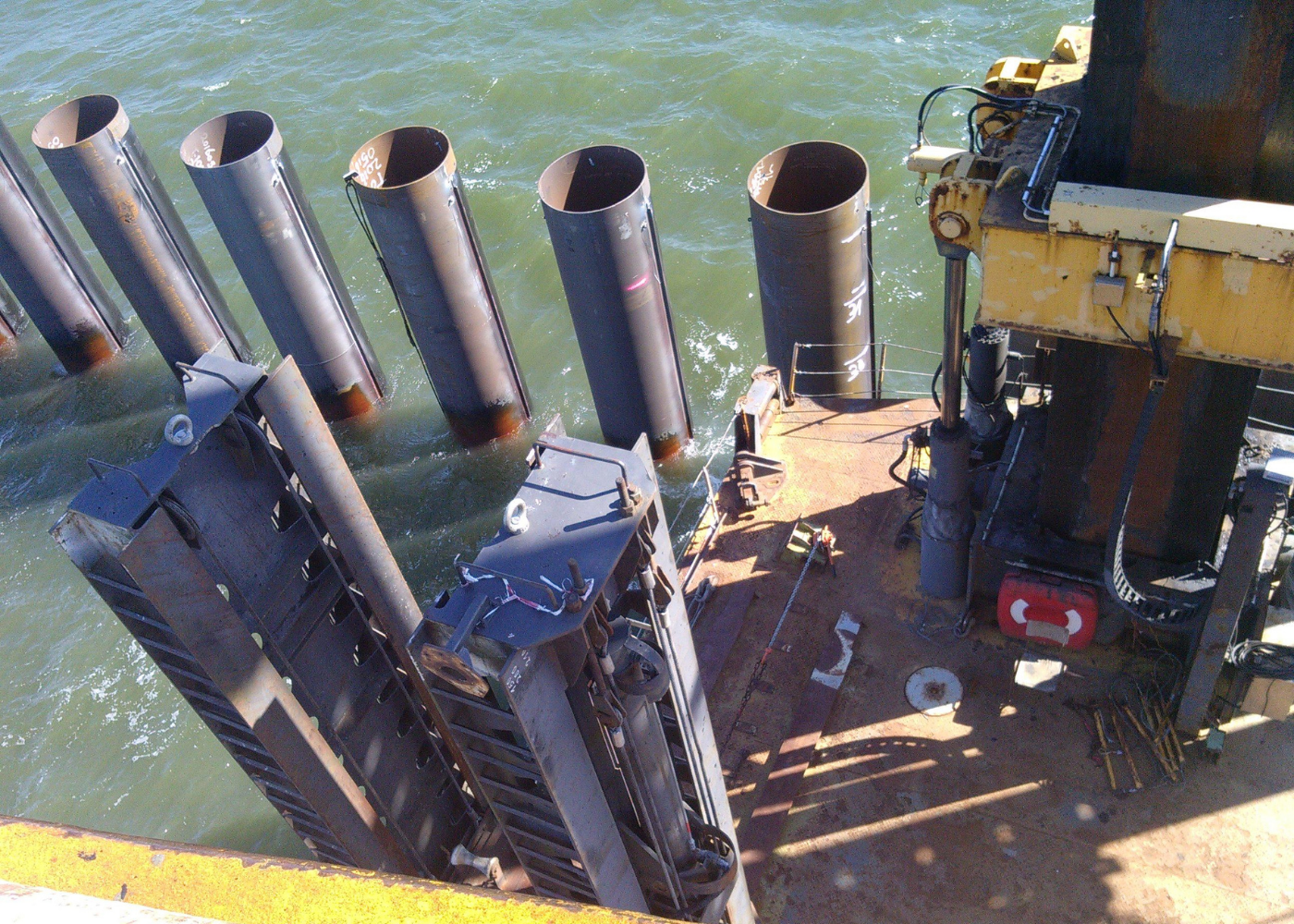
Types of King Piles
There are three main categories of king piles used in modern construction:
1. H Pile King Piles
Description: Standard hot-rolled or welded H beams acting as the king pile, with connectors welded to the upper flange.
Usage: Common in shallow or medium-depth retaining walls, cofferdams, and foundations.
Advantages:
- Easy to install with vibratory hammers.
- Welded H beams allow custom flange width/depth to tune section modulus and fit waling geometry.
- Well-suited for integration with U- or Z-type regular sheet piles.
- Economical option for medium load-bearing walls.
Practical note: Where wider king pile spacing is desired in a combi wall, increasing the top flange width on a welded H pile and tuning plate thicknesses can deliver the required section modulus with a more efficient weight distribution. This means fewer king piles need to be installed overall, reducing installation costs and accelerating construction — provided that each king pile is designed with sufficient section modulus (stiffness) to carry the increased bending loads safely.
2. Pipe Pile King Piles (Tubular Piles)
Description: Large-diameter tubular piles (e.g., LSAW or SSAW pipes) used as king piles, with clutches welded to the pipe to connect with infill sheet pile.
Usage: Commonly adopted in heavy-duty quay walls and combi wall structures where very high bending stiffness and axial capacity are required, such as deep-water ports, container terminals, and bulk handling facilities.
Advantages:
- High stiffness and axial capacity make them ideal for deep embedment and heavy surcharge/berthing conditions.
- Flexibility in diameter and wall thickness, allowing dimensions to be adapted to project-specific geotechnical and structural requirements.
- Clutches can be welded anywhere around the pipe’s 360° circumference, enabling flexibility in wall alignment, corners, and transitions.
- Robust under cyclic loading conditions — such as repeated wave, tide, and berthing forces typical in marine environments.
- Fewer piles are needed compared to H-pile systems, since large-diameter pipes cover more wall width and provide higher individual stiffness.
3. Box Pile King Piles (Box Sheet Piles)
Description: Box sheet piles fabricated by welding two sheet piles (typically U or Z) into a closed box; sometimes concrete-filled. This gives the pile much greater stiffness and strength compared to a single sheet pile, while maintaining full compatibility with standard sheet pile walls.
Usage: Box piles are typically inserted at specific points in a sheet pile wall where higher loads or concentrated forces must be resisted, such as under heavy structures, mooring points, or transitions.
Advantages:
- Higher stiffness than a single sheet pile; compatibility with sheet pile walls is excellent.
- Can serve as independent bearing piles, suitable for jetties, dolphins, and deep foundations.
- Can be placed anywhere within a sheet pile wall (same width) to take concentrated vertical or horizontal loads
- Can be filled (e.g., concrete) to enhance performance further.
- Typically installed open-ended, which reduces ground displacement and heave

Engineering Factors That Influence King Pile Design and Use
- Section modulus and spacing: Selecting king piles with a higher section modulus allows wider spacing (often ~2.0–3.5 m), which reduces the number of primary elements and the associated installation effort.
- Infill optimisation: With the king piles carrying the main bending loads, lighter infill sheet piles can be used, reducing overall steel tonnage.
- Connection efficiency: Adequate flange width (especially in H-beams) simplifies waling and tie-rod detailing, improving fabrication and on-site assembly.
- Driving strategy: Pile geometry (H vs. tubular) influences penetration behaviour. Toe shoes are often used in rubble or mixed ground, and the choice of vibratory, impact, or press-in methods depends on soil conditions, noise restrictions, and settlement risks.
- Durability and life-cycle: Long-term performance depends on protective measures. Coatings should comply with ISO 12944 classes (e.g., C5-M for splash/tidal zones), with corrosion allowances and specific detailing at mudline and splash zones to manage long-term thickness loss.
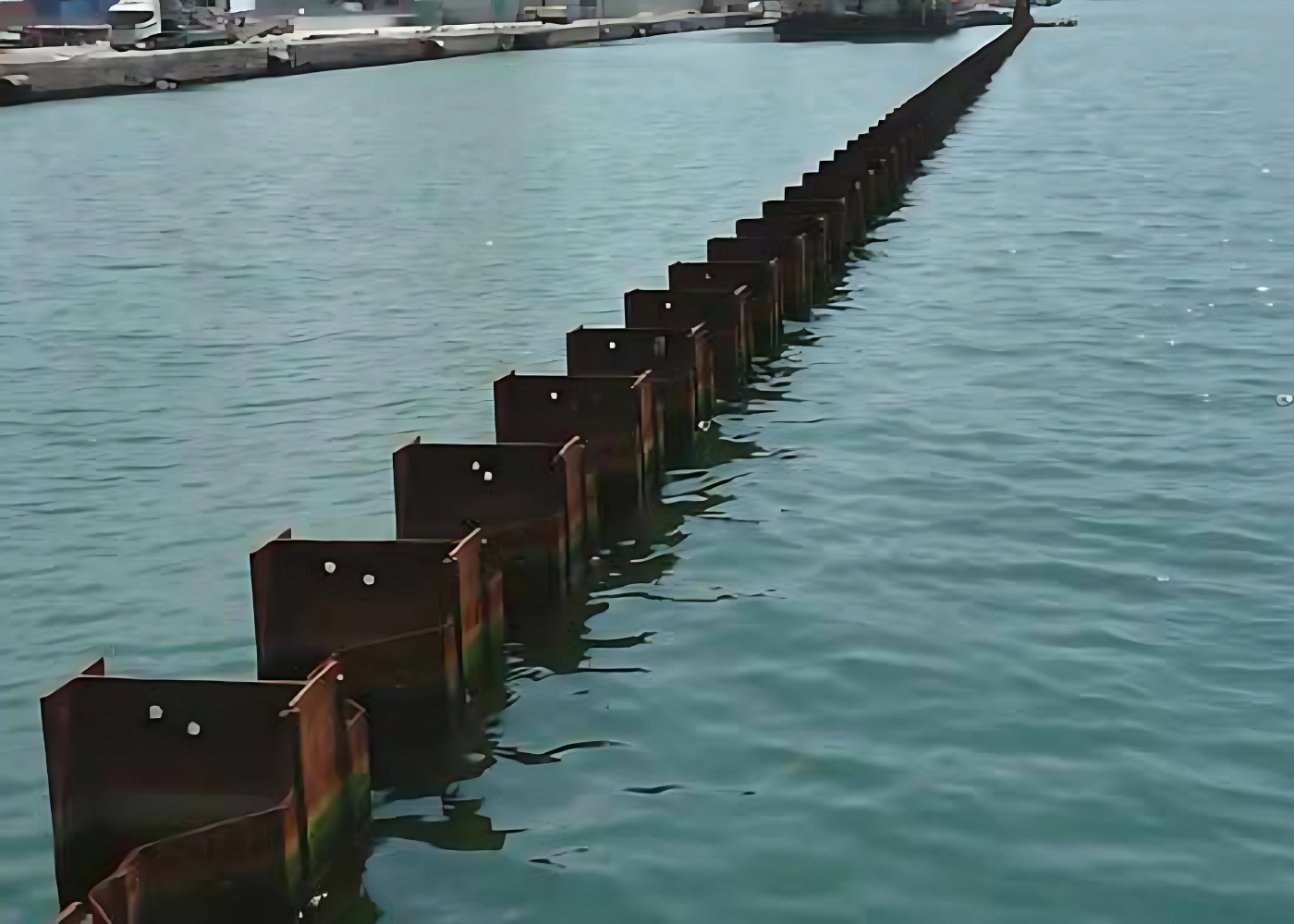
King Piles in Combined Wall Systems
A king pile combi wall (combined wall system) is a retaining wall formed by alternating king piles and intermediary sheet piles. The king piles act as the primary load-bearing members, while the sheet piles serve mainly as soil retainers. This configuration provides the high stiffness and strength required for modern quay walls, deep excavations, and other waterfront structures.
Main components:
- King Piles: Installed at regular intervals (typically 2.0–3.5 m centres depending on design requirements), they resist most of the bending moments and axial forces from earth and water pressure.
- Infill Sheet Piles: Lighter sheet piles are driven between the king piles. Their role is to close the wall, retain soil, and transfer load into the king piles through welded or interlocked connectors.
- Tie Rods and Walings: Loads from the wall are distributed into the soil or anchor structure behind via tie rods, with walings (horizontal beams) spreading the forces evenly.
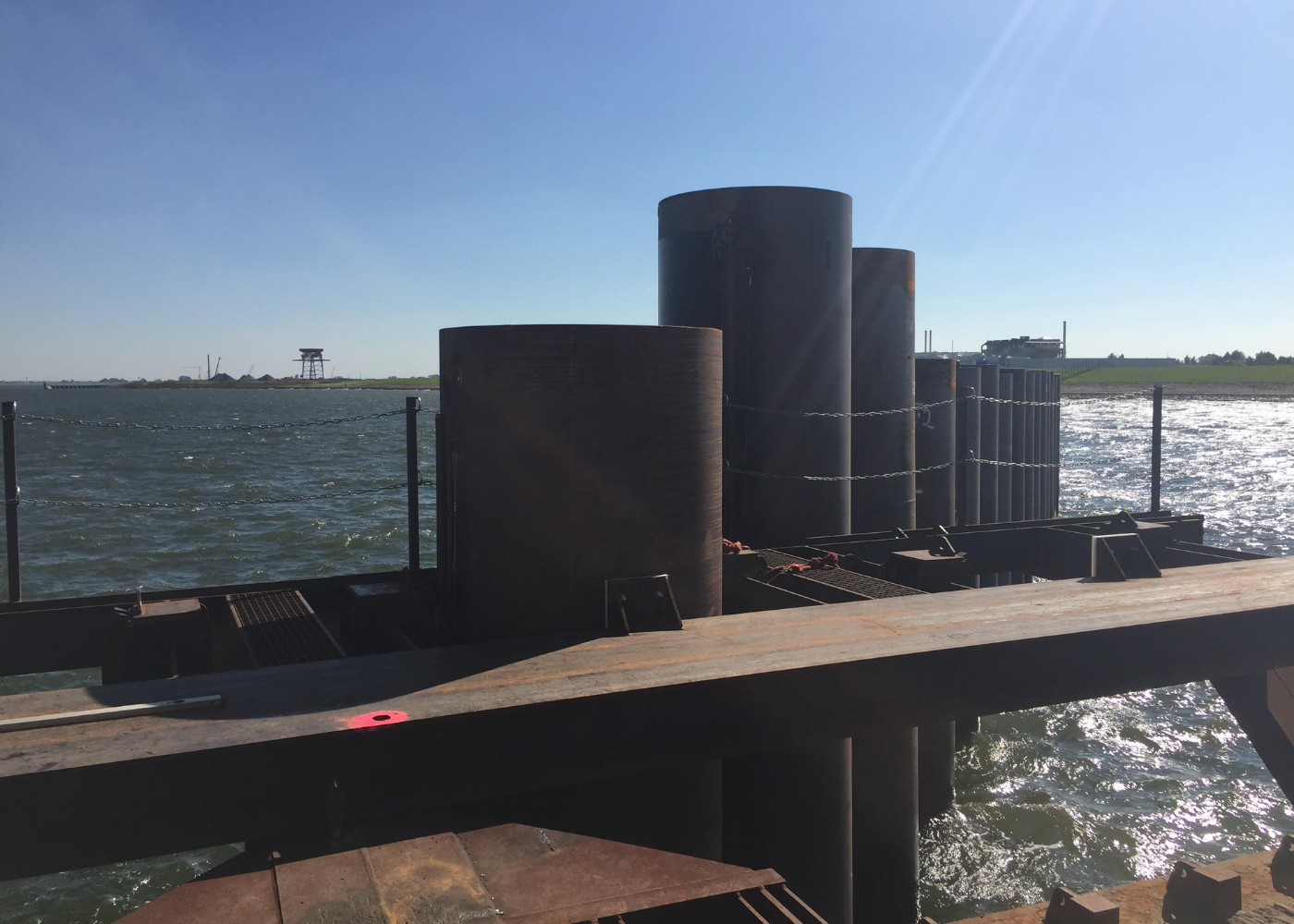
Applications of King Piles
King piles are indispensable wherever retaining walls must combine high stiffness, deep embedment, and long service life. Their ability to carry significant bending moments and axial loads makes them a cornerstone of modern marine and civil engineering projects.
Ports and Harbours
- Quay walls, container terminals, shipyards, and bulk terminals.
- King piles provide the stiffness to withstand berthing forces, heavy crane loads, and deep-water pressures.
Locks and Dams
- Used in approach walls, abutments, and retaining structures around waterways.
- Provide stability where concentrated loads from gates or ship impacts must be resisted.
Flood Protection and Coastal Defences
- Sea walls, levees, and dikes.
- King piles ensure long-term resistance to wave action, tidal fluctuations, and storm surges.
Cofferdams and Temporary Works
- Support deep excavations in marine or river environments.
- Reusable in many cases, offering a cost-effective solution for temporary structures.
Industrial and Infrastructure Foundations
- Support for refineries, coastal plants, and heavy machinery.
- Provide axial and lateral capacity where high vertical loads and vibrations are present.
Manufacturing and Standards for King Piles
King piles are manufactured in different forms — hot-rolled H beams, welded H piles, tubular pipe piles, and box sheet piles. Regardless of type, production and quality control must follow recognised international standards to ensure safety, performance, and compliance.
Relevant Product Standards:
- EN 10248 – Hot-rolled sheet piles/H beams
- EN 10249 – Cold-formed sheet piles
- EN 10219 – Welded structural hollow sections (used for tubular piles)
- EN 10025 – Structural steel grades (e.g., S355, S460)
Execution and Welding Standards:
- EN 1090-2 – Execution of steel structures (EXC3/EXC4)
- EN ISO 3834-2 – Welding quality requirements
- ISO 15614-1 / EN ISO 9606-1 – Welding procedures and welder qualifications
Quality Assurance:
- Mill Test Certificates (EN 10204 3.1 / 3.2)
- Non-destructive testing (UT, MT, RT) for welds and joints
- Dimensional inspections for pile geometry and connector alignment
Surface Protection:
- Protective coatings per ISO 12944 (C5-M for splash/tidal zones)
- Hot-dip galvanising per EN ISO 1461 (where specified)
- Corrosion allowances and detailing at mudline/splash zones
Conclusion: Why King Piles Matter
King piles are the backbone of combi walls, providing the stiffness and load-bearing capacity that sheet piles alone cannot achieve. Whether H-piles, tubular pipes, or box sheet piles, they enable the safe and economical construction of quay walls, locks, flood defences, and deep retaining structures.
King piles ensure that infrastructure is safe, resilient, and long-lasting. Their adaptability, compatibility with infill piles, and compliance with global standards make them an essential solution in today’s complex engineering environment.
Related Products from Aema Steel
- Welded H Piles
- Steel Pipe Piles
- Steel Tie Rod Systems
- Hot Rolled U Type Sheet Piles
- Hot Rolled Z Type Sheet Piles
Contact us today to receive a tailored offer for your upcoming project.

